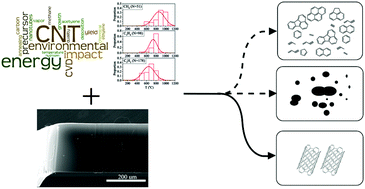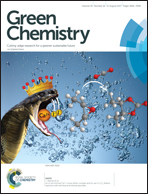The carbon nanotube formation parameter space: data mining and mechanistic understanding for efficient resource use†
Abstract
Carbon nanotube (CNT) synthesis via catalytic chemical vapor deposition is relatively energy consumptive and among the least efficient reactions with respect to carbon conversion efficiency. Interestingly, these processes can be fed using a diverse set of hydrocarbon starting materials, including methane, ethylene, and acetylene, over a wide range of operating temperatures and carbon-to-hydrogen feedstock ratios. Mapping the parameter space for successful CNT growth through data extraction from published literature illuminated the most energy- and material- efficient synthetic pathways in practice to date and provided insights on thermodynamic limitation of CNT growth (i.e., the fundamental mechanisms of CNT formation). Further experimental investigations confirmed that emergent trends in the literature were the result of physicochemical constraints on the process rather than behavioral inertia in the community. The initiation temperatures for CNT growth from acetylene, ethylene, and methane feedstocks via direct experimentation were 550, 700, and 950 °C, respectively, consistent with the trend in literature-extracted mean optima (642 ± 128, 739 ± 82, and 858 ± 125 °C, respectively). These relative temperatures are consistent with a universal CNT growth mechanism, wherein all carbon feedstocks are converted to alkyne-containing species that serve as direct precursors for CNT growth. Mitigating this step with rational carbon precursor delivery, rather than relying on heat to generate the most reactive precursors in situ, could largely reduce the environmental burdens in CNT manufacturing. Indeed, manipulating the starting gas-phase composition and minimizing the thermal treatment through the use of C2H2 increased carbon conversion yield by a factor of more than 10 compared to C2H4, and, consequently, should minimize hazardous volatile organic compound and polycyclic aromatic hydrocarbon emissions. The methodology utilized in this study is transferrable to guide the green synthesis of other materials and should be automated in the future for high-throughput screening of the vast process chemistry literature.

- This article is part of the themed collection: Green Chemistry 2017 Emerging Investigators


 Please wait while we load your content...
Please wait while we load your content...